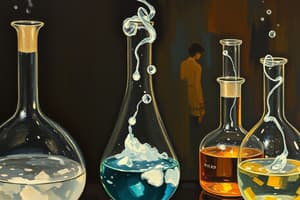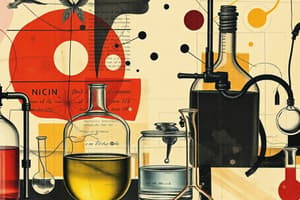Podcast
Questions and Answers
क्रोमैटोग्राफी क्या है और यह किस आधार पर मिश्रण के तत्वों को अलग करती है?
क्रोमैटोग्राफी क्या है और यह किस आधार पर मिश्रण के तत्वों को अलग करती है?
क्रोमैटोग्राफी मिश्रण के तत्वों को उनकी भौतिक और रासायनिक गुणों के आधार पर अलग करती है, जैसे कि धारिता, आवेश या आकार।
एक्सट्रैक्शन क्या है और इसका किस आधार पर उपयोग किया जाता है?
एक्सट्रैक्शन क्या है और इसका किस आधार पर उपयोग किया जाता है?
एक्सट्रैक्शन उपयोग की गई सॉल्वेंट के विभिन्न सोल्यूबिलिटी पर आधारित होता है, जिससे वांछित यौगिक की सोल्यूबिलिटी को पसंद किया जाता है, जिससे उसका अन्य तत्वों से अलगाव होता है।
इलेक्ट्रोफोरेसिस क्या है और यह किस विशेषता पर आधारित है?
इलेक्ट्रोफोरेसिस क्या है और यह किस विशेषता पर आधारित है?
इलेक्ट्रोफोरेसिस विभिन्न आकार और आवेश में अंतर पर आधारित होता है।
फ्रैक्शनल क्रिस्टलाइजेशन क्या है और यह कैसे काम करता है?
फ्रैक्शनल क्रिस्टलाइजेशन क्या है और यह कैसे काम करता है?
आयन एक्सचेंज क्या है और इसका उपयोग क्यों किया जाता है?
आयन एक्सचेंज क्या है और इसका उपयोग क्यों किया जाता है?
कौन सा विधुत वर्ग कैर्बनिक यौगिक में अधिक संभावित है?
कौन सा विधुत वर्ग कैर्बनिक यौगिक में अधिक संभावित है?
कौन सी संरचनात्मक इसोमर का उदाहरण है?
कौन सी संरचनात्मक इसोमर का उदाहरण है?
कौन-कौन से प्रकार के स्टीरियोआइसोमर होते हैं?
कौन-कौन से प्रकार के स्टीरियोआइसोमर होते हैं?
किस प्रकार के स्टीरियोइसोमर के मोलेक्युल का प्रकाश में मिलन होता है?
किस प्रकार के स्टीरियोइसोमर के मोलेक्युल का प्रकाश में मिलन होता है?
कौन-कौन से स्टीरियोआइसोमर Enantiomers होते हैं?
कौन-कौन से स्टीरियोआइसोमर Enantiomers होते हैं?
आयातीय संख्या क्या है और इसका ज्ञान रखना महत्वपूर्ण क्यों है?
आयातीय संख्या क्या है और इसका ज्ञान रखना महत्वपूर्ण क्यों है?
Flashcards are hidden until you start studying
Study Notes
Overview of Organic Chemistry
Organic chemistry studies the structure, properties, and reactions of organic compounds, primarily those consisting of carbon and hydrogen. While the field initially focused on molecules produced by living organisms, it has since grown to encompass synthetic substances as well. The primary goal of organic chemistry is to understand the relationships between molecular structure and properties to develop new applications, processes, and technologies.
Purification Techniques in Organic Chemistry
The purification of organic compounds is crucial for achieving high yields and product quality. Several methods exist to purify and separate organic compounds, including:
-
Filtering: This technique separates solids from liquids or gases based on differences in particle size or solubility. For instance, gravity filtration uses a filter paper to retain solids while allowing liquids to pass through.
-
Crystallization: Crystallization is used to purify solid organic compounds. The compound is dissolved in a solvent, then allowed to cool and form crystals. The crystals are collected to obtain a pure product.
-
Distillation: This method separates organic compounds based on differences in boiling points. Heating a mixture of organic compounds until one component vaporizes allows for the collection of a purified product upon condensation.
-
Chromatography: Chromatography separates mixtures of compounds based on their physical and chemical properties, such as polarity, charge, or size. This technique is useful for purifying complex mixtures of organic compounds.
-
Extraction: Extraction separates components based on their solubility in different solvents. The solvent is chosen to favor the solubility of the desired compound, leading to its separation from other components.
-
Fractional crystallization: This process combines crystallization with repeated crystallizations to isolate pure components based on differences in solubility at different temperatures.
-
Electrophoresis: Electrophoresis separates components based on differences in charge and size.
-
Ion exchange: This technique separates components based on differences in charge.
-
Ultrafiltration: Ultrafiltration separates components based on differences in size and shape.
-
Precipitation: Precipitation separates components based on differences in solubility.
The choice of purification technique depends on the specific characteristics of the substance being purified, as well as the desired level of purity and the amount of material to be purified. In some cases, multiple techniques may be combined to achieve a high degree of purity.
Studying That Suits You
Use AI to generate personalized quizzes and flashcards to suit your learning preferences.




